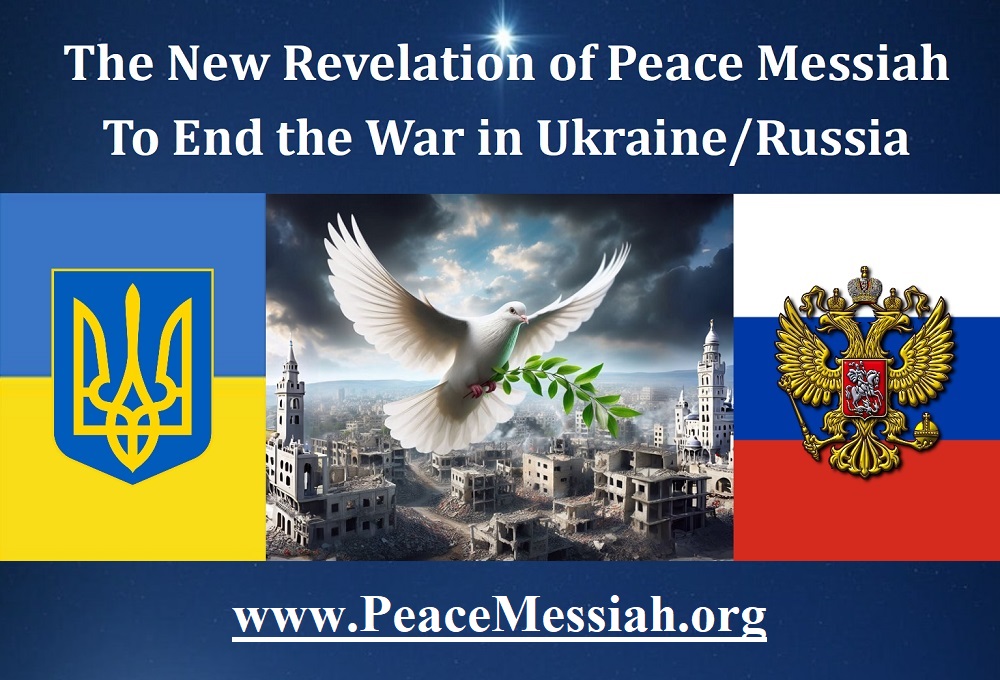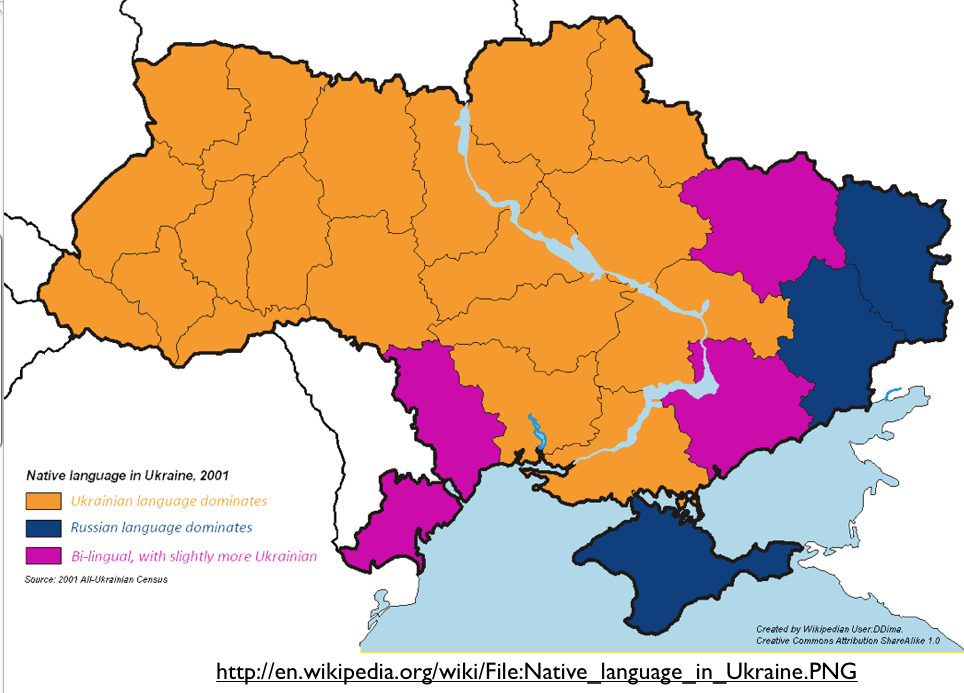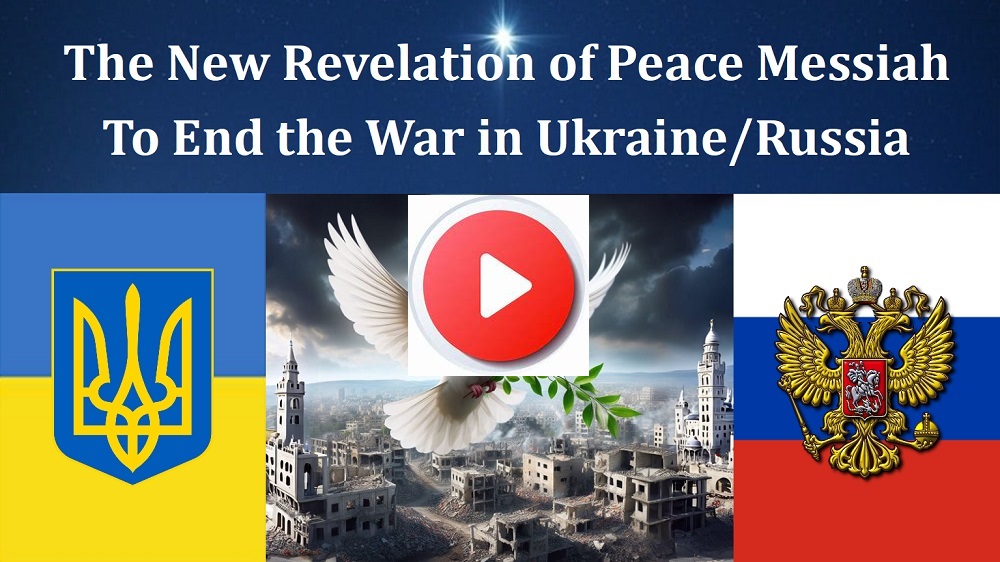The Peace Messiah Revealed the Divine Revelation of God on a Fair Settlement to End the War in Ukraine and Russia

(August 15, 2025, Salt Lake City) Three years ago, Russia launched a full-scale invasion of Ukraine from the north, south and east in the name of “Special Military Operation” on February 24, 2022. It has caused over one million people to be killed or be injured in this war and more than ten million people to lose their homes since the war broke out in February 2022. It is time to end this war and stop the senseless killing between these two former brotherly nations.
Today, President Donald Trump of the United States is scheduled to meet with Russian President Vladimir Putin in Alaska to discuss a peace plan to first established a ceasefire and then end the war between Russia and Ukraine. However, Putin has made excessive territorial demands as the condition for a ceasefire, which are most likely to be rejected by Ukraine and the European Union.
To end the war between Ukraine and Russia, the final settlement needs to be fair to both Ukraine and Russia. Since both sides cannot reach an agreement over the territorial disputes, here is the Divine Revelation from the Peace Messiah on the Fair Settlement to end the war in Ukraine/Russia.
1. The Fair Settlement on Crimea:
Russia Can Keep the Crimea under Joint Government with Ukraine
Crimea has been the root of the conflicts between Ukraine and Russia since the Euromaidan Revolution in 2014. To make a fair settlement on Crimea, we need to look back at the history of Crimea.
Crimea had been part of the Greek/Roman Empire and their successor state, the Byzantine Empire, for almost two thousand years before the Mongol armies invaded it in 1238. It then came under control of the Ottoman Empire in the 1440s until the Russian Empire took control in 1783, which lasted until the Soviet Union era in the twentieth century.
In 1954, the leader of the Soviet Union, Nikita Khrushchev, gifted Crimea to Ukraine as a symbol of brotherhood between Russia and Ukraine. Even after the collapse of the Soviet Union in 1990 and Ukraine became an independent nation in 1991, Ukraine still maintained good relations with Russia and allowed Russia’s Black Sea Fleet to be stationed at Crimea. Thus the majority of Crimea’s residents are ethnic Russians.
However, that good relationship between the two nations deteriorated after the Euromaidan Revolution in February 2014, when the pro-Russian president was overthrown and anti-Russian sentiment grew across western Ukraine. The majority of ethnic Russians in Crimea wanted to return to Russia rather than remain in an Anti-Russian Ukraine. That’s why Russian President Putin deployed the Russian Special Forces to seize strategic sites across Crimea on February 27, 2014.
On March 1, 2014, Russia had complete control of Crimea. On March 16, 2014, the Crimean people held a Referendum to declare independence from Ukraine and join Russia. The official result was a 97 percent vote for integration of Crimea into the Russian Federation, with an 83 percent voter turnout. On March 18, 2014, Crimea was annexed by Russia.
Although both Ukraine and the United Nations do not acknowledge this annexation, we should not deny the will of the majority of the people in Crimea. However, since Crimea had been part of Ukraine for over sixty years, we should also honor this part of history.
Therefore, the fair solution to the dispute of Crimea is to acknowledge the current status of Crimea as part of the Russian Federation, while establishing a joint government by both Russians and Ukrainians in Crimea to protect the right of Ukrainians in Crimea. The new Crimean government should grant all Ukrainian citizens equal legal rights as Russian citizens to travel, vacation, work and live in Crimea. The joint government in Crimea would be the first step toward rebuild the relationship between these two former brotherly nations.
2. The Settlement on the Four
Oblasts (States) in Southeast Ukraine:
Russia and Ukraine Split the Four Oblasts, with Russia taking Donetsk and Luhansk and Ukraine Regaining Zaporizhia and Kherson
Currently, the biggest obstacle to ending the war in Ukraine is the territorial dispute over the four oblasts in Southeast Ukraine that have been occupied by Russia since it invaded Ukraine in February 2022. Russia demands Ukraine to give up the territories they occupied in these four oblasts—Donetsk, Luhansk, Zaporizhia, and Kherson— but Ukraine vows it will never give up its land in these regions. The two sides are too far apart in their territorial demand to reach a deal at this moment.
According to international law, the Russian invasion of Ukraine in February 2022 is an illegitimate war that violated the sovereign right of an independent country. If the international community accepts Russia’s demand to permanently annex its occupied territories through invasion, then all major powers could bully smaller neighbors and seize their land by force. Such a precedent would undermine the international order, and there will be no more peace and justice for the world.
Accepting Russia’s full demand on its occupied territories would reward aggression and encourage future invasions once the sanctions are lifted. That’s why no country except North Korea recognizes the Russian occupation of the four oblasts in Southeast Ukraine as legitimate and all Western nations have imposed severe sanctions on Russia for its invasion of Ukraine.
However, if Russia and Ukraine cannot reach a fair settlement on these four oblasts, the war will never end, and hundreds of thousands or even millions of people will lose their lives as the war drags on. That’s why President Donald Trump seeks to push for a ceasefire leading to a final peace agreement, in order to avoid further loss of life among both Ukrainians and Russians.
Therefore, the most equitable way to settle the territorial disputes on the four oblasts in Southeast Ukraine is to base the division on the ethnic majority in the areas before Russia invaded Ukraine in 2022.

Since the majority of residents in Donetsk and Luhansk were ethnic Russians before the war, Russia can keep the territories it occupied in these two oblasts. However, as the majority of ethnic population in Zaporizhia and Kherson were ethnic Ukrainians, Russia should return the territories it occupies in Zaporizhia and Kherson to Ukraine.
Since the Euromaidan Revolution in 2014, ethnic Russians in the Donbas region of Donetsk and Luhansk have sought separation from the pro-Western Ukrainian government—either to rejoin Russia or to become independent from Ukraine. They voted in favor of independence in a referendum on May 11, 2014. At the same time, those pro-Ukrainian residents in the other parts of Donetsk and Luhansk also held a counter-referendum to remain in Ukraine through accession to Dnipropetrovsk Oblast.
From that point on, the Ukrainian government forces and pro-Ukrainian militias had been fighting with the pro-Russian separatists in the Donbas, with those ethnic Russians in the region enduring Ukrainians’ attacks and bombardment for eight years. This was one of the main causes cited by Russia for its full-scale invasion into Ukraine in 2022.
Therefore, it’s fair for the ethnic Russians in the Donbas region to determine whether they wish to remain in Ukraine, become independent, or join Russia. Now that Russia controls all of Luhansk and most of Donetsk, Ukraine should accept the will of the majority in Donbas, as well as the reality of Russian control in these areas, in exchange for regaining some or all of the territories in Zaporizhia and Kherson. Western Donetsk should remain in Ukraine through accession to Dnipropetrovsk Oblast, as per the 2014 counter-referendum.
Regarding the Russian-occupied territories in Zaporizhia and Kherson, since most residents are ethnic Ukrainians and ethnic Russians account for less than 25% of the population, Russia should return all or part of these regions to Ukraine. Although Russia held referendums there after its 2022 invasion, these votes—conducted under military occupation—are not recognized as valid by the international community.
Without Zaporizhia and Kherson, Eastern Ukraine would be landlocked and unable to export agricultural products via the Sea of Azov. It’s critical for Ukraine to secure some access to the Sea of Azov in the final peace agreement. At the same time, Russia also wants to have a land corridor between Donetsk and Crimea for its supplies to be transported to Crimea. Both sides have some legitimate demand for these territories.
Therefore, the best way to settle the territorial dispute of Zaporizhia and Kherson Oblast is to follow the joint-government model of Crimea- but in reverse. The sovereignty of Zaporizhia and Kherson would belong to Ukraine, with a joint Ukrainian-Russian administration to protect the rights of ethnic Russians and guarantee Russia’s right to use a land corridor, including its railway system, to Crimea.
Such a joint government could serve as a powerful symbol of reconciliation between the two brotherly nations, much like the healing that followed the American Civil War between the Union and the Confederacy.
However, given Russia’s current military advantage in manpower and missile stockpiles, convincing Moscow to accept this Divine Revelation on the four oblasts will be challenging. It will require significant faith, love, and mercy from Russia’s leaders to end the war in accordance with God’s will. If the conflict continues, more lives will be lost and more homes and cities destroyed—outcomes that are not in line with our Heavenly Father’s desires.
If Russia continues the war, European nations will further increase defense spending and military support for Ukraine. In 2024, EU member states collectively spent €326 billion on defense—about 1.9% of GDP—while Russia spent about $146 billion, or 7% of its GDP, less than half the EU’s defense budget. Given that the EU’s GDP is roughly $20 trillion—nearly 10 times Russia’s $2.16 trillion—the EU could easily outspend Russia militarily. Germany alone, with a GDP of $4.66 trillion, has an economy more than twice the size of Russia’s. Once Europe’s war machine is fully mobilized, Russia would lose its current military edge.
With advanced U.S. weaponry and growing European defense budgets, Russia cannot make further territorial gains. Its economy could not sustain a long war and would eventually collapse. It would be wiser for Russia to follow the Divine Revelation of God from the Peace Messiah—keeping Crimea, Luhansk, and Donetsk, where most residents are ethnic Russians, and returning Zaporizhia and Kherson to Ukraine.
3. The Compensation after the War:
Russia Should Compensate Ukraine for the War Damage through its Oil and Natural Gas Once the International Sanctions are Lifted
Since Russia’s invasion of Ukraine in February 2022, the conflict has caused extensive destruction to Ukrainian cities and infrastructure. Millions of Ukrainians have lost their homes, with many forced to seek refuge in neighboring countries. It is Russia’s responsibility to provide compensation for the damage it has inflicted. If the war continues for years, the devastation will only deepen for both nations—potentially extending to Russia’s own major cities, refineries, and infrastructure. Prolonging the conflict, or escalating it toward a potential World War III, is not a worthwhile path over the territorial disputes on such a small piece of land, comparing to the large territories of the Russian Federation.
Given Russia’s abundant oil and natural gas resources, a practical form of compensation would be for Russia to supply Ukraine with natural gas through Ukraine’s pipelines once international sanctions are lifted. This arrangement would help restore Ukraine’s economy while enabling both countries to benefit from renewed energy cooperation. It is time for these two formerly brotherly nations to make peace and begin rebuilding their futures.
4. Long-Term Security Guarantees for Ukraine without Joining NATO for Now
One of Russia’s main justifications for its invasion was its opposition to Ukraine joining NATO. Moscow has repeatedly stated that NATO expansion toward its borders is a “red line”. On the other hand, Ukraine seeks strong security guarantees to prevent future invasions.
The most viable compromise is for Ukraine to adopt a permanent, constitutionally enshrined status of military neutrality—similar to Austria’s model—while receiving binding international defense guarantees from major powers such as the United States, the United Kingdom, France and Germany.
Instead of joining NATO, Ukraine can join the European Union for economic development and deeper relationship with European nations. That economic alliance with the European Union with security guaranty from the major powers in the world would provide solid protection for Ukraine to deter any future aggression from Russia. Once Ukraine reaches a peace agreement with Russia, Ukrainians can focus their effort on rebuilding their war-torn country. God has mercy on Ukrainians who have suffered the destruction of the war for the last three years. It’s time to end this war in Ukraine once for all.
This is the Divine Revelation of God through the Peace Messiah for a peaceful resolution to the war between Ukraine and Russia.
“Blessed are the peacemakers, for they will be called the children of God.” — Matthew 5:9
Download the pdf of this article.
For more detailed information on the full version of the Divine Revelation of the Peace Messiah on the Peaceful Solution to End the War in Ukraine, please visit:
www.PeaceMessiah.org/Ukraine.htm
or watch the video on YouTube: https://youtu.be/t4oQA6OrEEA.

